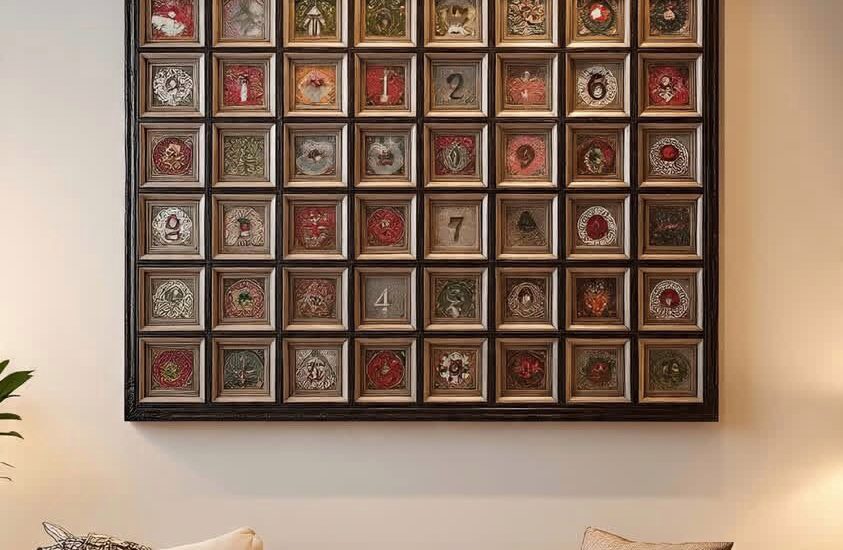You know that feeling when December first rolls around and you get to open that first tiny door? Even as an adult, I still get a little thrill from it. Advent calendars have this weird power to transform the entire month of December into something more than just a countdown. They turn waiting into an event, and somehow manage to make time feel both slower and more exciting at the same time. Discover the fascinating history of Advent calendars and creative ideas to make December special.
The whole tradition actually goes back further than most people realize. We are talking about early 19th-century Germany here, where Protestant families wanted to help their children understand the religious significance of the days leading up to Christmas. Back then, they would mark chalk lines on doors or light candles to count down the days. It was not exactly the chocolate-filled extravaganza we know today, but the concept was there. Parents were essentially creating a physical manifestation of anticipation, giving kids something tangible to hold onto while they waited for Christmas morning.
The first actual printed advent calendar appeared around 1902, created by a German publisher. His mother had apparently made him a homemade version as a child, attaching small candies to cardboard, and he never forgot the joy it brought him. Funny how childhood memories drive us to recreate experiences, is it not? That same impulse is probably why so many of us insist on buying advent calendars for ourselves now, even when nobody is making us do it.

Fast forward to today, and the advent calendar market has absolutely exploded. Walk into any store in November and you will find yourself drowning in options. Chocolate calendars remain the classic choice, and I have to admit I am a sucker for the traditional milk chocolate ones, even though I know fancier versions exist. But the evolution has been wild. Beauty companies now sell calendars packed with miniature skincare products and makeup samples. Tea companies offer 24 different varieties to sample. I have even seen calendars filled with hot sauce, which seems both brilliant and slightly terrifying.
My neighbor collects LEGO advent calendars every year, and watching her build a tiny new creation each morning with her coffee has become part of my own December routine when I see her through the window. It speaks to how these little traditions ripple outward, creating moments of connection even when we are not directly participating. The ritual matters more than the contents sometimes.
What really gets me about advent calendars is how they force us to slow down in a month that usually feels like a freight train. You cannot rush through all the doors at once, well, you can, but then you have defeated the entire purpose and probably feel a bit sick if it is chocolate. The structure creates discipline in the midst of holiday chaos. One day, one treat, one moment of pause. In our instant gratification culture, that enforced patience feels almost revolutionary.
Creating your own advent calendar has become increasingly popular, and honestly, it might be even better than buying one. You can tailor it exactly to the person receiving it. For kids, mixing small toys with candy keeps things interesting. For your partner, combining their favorite treats with little notes or experience vouchers turns it into something deeply personal. I made one last year for my sister filled with tea samples, chocolate, and tiny bottles of nail polish. The joy on her face each morning when she texted me about what she found made my entire December better.

The religious origins have not disappeared either, even as commercial versions dominate. Many families still use advent calendars as a way to teach the Christmas story, with each day revealing a piece of the nativity scene or a relevant Bible verse. Some contain activities focused on giving rather than receiving, like doing a kind deed or donating to charity. This twist on the tradition reminds us that advent originally meant preparation and reflection, not just consumption.
If you want to try making your own advent calendar this year, the options are genuinely endless. Small paper bags numbered and hung on a string create a rustic look. Matchboxes glued together and painted make surprisingly cute individual compartments. Empty toilet paper rolls can be transformed into a calendar with some wrapping paper and creativity. Fill them with whatever makes sense for your household. Maybe it is quotes, maybe it is activities to do together, maybe it is just really good chocolate because sometimes that is enough.
References
Journal of Consumer Research (Oxford Academic) – publishes research on consumer behavior and culture
Journal of Consumer Culture (Sage) – covers consumption and consumer culture studies
Consumption Markets & Culture (Taylor & Francis)

